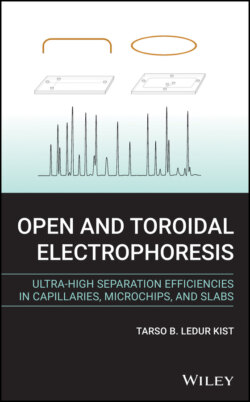Читать книгу Open and Toroidal Electrophoresis - Tarso B. Ledur Kist - Страница 2
Table of Contents
Оглавление1 Cover
2 Preface
3 Acronyms
4 Symbols and Conventions
5 Introduction
6 1 Solvents and Buffer Solutions 1.1 Water as a Solvent 1.2 Binary Mixtures and Other Solvents References
7 2 Fundamentals of Electrophoresis 2.1 Introduction 2.2 The Platforms 2.3 Electrophoresis 2.4 Electrophoresis of Single Molecules 2.5 Ionic Limiting Mobility 2.6 Bands, Fronts, Peaks, and Zones 2.7 The Isoelectric Point 2.8 Turbulent and Laminar Flow 2.9 Electroosmosis 2.10 Supression of EOF 2.11 Joule Effect and Heat Dissipation 2.12 Temperature Profiles 2.13 Molecular Diffusion and Band Broadening 2.14 Sample Stacking and Band Compression 2.15 Separation Modes References
8 3 Open Layout 3.1 Introduction 3.2 Capillary Electrophoresis 3.3 Microchip Electrophoresis 3.4 Slab Electrophoresis 3.5 Performance Indicators for Open Layouts References
9 4 Toroidal Layout 4.1 Introduction 4.2 Toroidal Capillary Electrophoresis 4.3 Toroidal Microchip Electrophoresis 4.4 Toroidal Slab Electrophoresis 4.5 Folding Geometries 4.6 Microholes and Connections 4.7 Reservoirs 4.8 Active and Passive Modes of Operation 4.9 Performance Indicators for Toroidal Layouts References
10 5 Confronting Performance Indicators 5.1 Introduction 5.2 Performance Indicators from Experimental Data 5.3 Performance Indicators Predicted from Operational Parameters References
11 6 High Voltage Modules and Distributors 6.1 Introduction 6.2 High Voltages in Open Layouts 6.3 High Voltages in Toroidal Layouts References
12 7 Heat Removal and Temperature Control 7.1 Introduction 7.2 Temperature Gradients are Unavoidable 7.3 Temperature has Multiple Effects 7.4 Electrical Insulators with High Thermal Conductivity 7.5 Cooling Strategies Used in Capillary Electrophoresis 7.6 Cooling Strategies Used in Microchip Electrophoresis 7.7 Cooling Strategies Used in Slab Electrophoresis 7.8 Shear Rate of the Coolant 7.9 Final Considerations References Note
13 8 Detectors 8.1 Introduction 8.2 Fixed Point Detectors 8.3 Spatial Detectors (Scanners and Cameras) 8.4 Derivatization Reactions References
14 9 Applications of Toroidal Electrophoresis 9.1 Introduction References
15 Appendix A: Nomenclature References
16 Appendix B: Species Concentration in Buffer Solutions B.1 Acids (HnA) B.2 Bases (B) References
17 Appendix C: Electrophoresis C.1 Free-Solution Electrophoretic Mobility C.2 Mobility Dependence on Temperature C.3 Transient Regimes References
18 Appendix D: Electroosmosis D.1 Slab and Microchips – Cartesian Coordinates D.2 Capillaries – Cylindrical Coordinates D.3 Zeta Potential References
19 Appendix E: Molecular Diffusion E.1 The Diffusion Equation E.2 The Propagator E.3 Application of Propagators to Bands at Rest E.4 Application of Propagators to Bands in Movement E.5 Bands and Peaks References
20 Appendix F: Poiseuille Counter-flow F.1 Introduction F.2 Velocity Level Contours F.3 Temperature Level Contours F.4 Equalizing and Reference
21 Appendix G: Cyclic On-column Band Compression G.1 Introduction G.2 Effect of Cyclic Band Compression Events on Variance G.3 Number of Theoretical Plates G.4 Number of Theoretical Plates per Unit Time G.5 Height Equivalent of a Theoretical Plate G.6 Resolution G.7 Resolution per Unit Time G.8 Band Capacity G.9 Band Capacity per Unit Time G.10 Detailed Calculation of and References
22 Index
23 End User License Agreement
